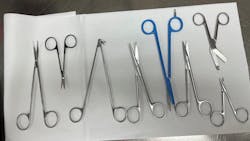Q: September’s edition asked: “One of my fellow workers will not use the non-latex material to test scissors. Instead, they use gauze. Is that acceptable?”
Let’s continue.
My assumption is your department might not have a written policy on testing scissors, which may be why your colleague is testing with something different than latex (artificial elastomer) material over gauze (an International Standards Organization [ISO] Standard). I found many statements inferring the use of latex as a test method back to 1990.
Under the “Inspecting/Testing” section called “Scissors: Check sharps for smooth edges,” it states, “Check blades for nicks and smooth blade function. Check for loose screws. Test cutting ability by using a material that imitates human tissue qualities. The scissors should cut evenly all the way through the material.”1
“Cut through a latex sheet with 3/4 of the blade. Latex provides slight resistance to simulate what your scissors would normally be cutting through. Make your initial cut with about 3/4 of the blade, leaving the 1/4 of the blade closest to your fingers off the latex.”2
In a program given by Storz on scissors, they say “sharp instruments (scissors, rongeurs, osteotomes, curettes, knives) should be tested for sharpness and smooth cutting under magnification.” They also state many facilities use TheraBand (e.g., exercise bands) to test sharpness of Mayo and Metzenbaum (“Metz”) scissors. “There are two thicknesses: one for scissors with blades longer than 5 inches, and one for scissors with blades less than 5 inches.”3
ASTM International’s Designation: F1079 – 87 (2017/R2022) standard supports using many different test materials (e.g., gauze, latex, etc.). “6.2 Cutting Ability—The test material shall comply with the material specified in Table 1, Table 2, or Table 3. Clean scissors to be tested prior to testing. … Any bending or snagging of the test material anywhere along the cut, including the distal tips, shall be cause for rejection.”4 Those three tables list all test materials highlighted in this two-part article.
I believe one reason for switching to a latex-type material was to reduce lint caused by gauze. Many different original equipment manufacturers’ (OEMs) instructions for use (IFU) give little to no direction on how to test the cutting edge. Rather, they focus on inspection.5
Personally, a department needs a general enough statement to cover all situations based on what I have presented. Some possible wording for a standard operating procedure (SOP) statement for testing scissors for sharpness is “As part of our functionality testing process, the various scissors in the department will be tested for sharpness (cutting edge) based on the review of the IFUs, standards, guidelines, and various technical literature on what materials (i.e., latex, non-latex, gauze, cotton balls, other material, etc.) should be used for testing the cutting edge of the medical devices.”
Also cite in the SOP’s footnotes the ASTM and ISO standards and various OEM IFUs of your department’s purchased scissors (Fig. 1). My suggested statement allows for this based on the information presented.
It is important to review the IFU(s) in your department. Follow them concerning testing your scissors for sharpness and adapt them to your practice.
Consider this: if the IFU states to use gauze (and you are not using gauze), how do you justify using something else to test your scissors? And if the source of your latex material does not give any reference, how do you know it can be used and justified if/when asked for by any surveyor?
The AKI “Red Book” says, “As surgical instruments are made for specific application purposes, the functional tests must be carried out so that items that fail to serve their intended purpose are reliably recognized and discarded. If in doubt, consult the instrument manufacturer for suitable testing methods.”6 This statement is a good summary for this two-part article.
I would purchase both the ISO and ASTM standards and review them for proper SOP documentation. You will now have the “Why,” to back up using gauze, latex-type, and/or other material in your department for testing scissors for sharpness.
Therefore, medical device reprocessing professionals need to make sure scissors (no matter the type) are clean and functional when placed in the tray. This means various scissors can functionally cut (per the different testing methods and references for use).
Being from Motown, I say know why “the way you do the things you do,”7 when testing scissors for sharpness.
References:
1. V. Mueller Division. (1990). V. Mueller Atlas of Surgical Instrument Care: A comprehensive program for cleaning and sterilization of surgical instruments. Baxter Healthcare Corporation.
2. Madden, H. (2021). How to Test the Sharpness of Scissors. wikiHow. Retrieved June 7, 2023, from https://www.wikihow.com/Test-the-Sharpness-of-Scissors.
3. Bausch & Lomb Incorporated. (2023). Bausch & Lomb Storz Ophthalmics Continuing Education. Bausch & Lomb Storz Ophthalmic Instruments. www.StorzOphthalmicCE.com.
4. ASTM International. (2017/R2022). Designation: F1079 – 87 (Reapproved 2022) Standard Specification for Inserted and Non-inserted Surgical Scissors. [Section 6.2 Cutting Ability, p. 1–2]. Formerly known as American Society for Testing and Materials (ASTM).
5. INTEGRA (2022, February). Surgical Instruments Indications for Use (KA202304) [JL-00032 Rev F. 2022-02 1486569-3]. Integra LifeSciences Production Corporation. Integra_LifeSciences_Surgical_Instruments_JL_00032_rF_202202.pdf.
6. AKI – Working Group Instrument Reprocessing. (2017). Instrument Reprocessing: Reprocessing of Instruments to Retain Value [aka "Red Book"]. (11th ed.) p. 50. www.a-k-i.org.
7. Temptations, The. (1999). The Way You Do the Things You Do [Song]. On Meet the Temptations. Gordy (GS-911); Motown.
About the Author

Stephen M. Kovach
Stephen M Kovach, BS, CFER, started in the medical field in 1975 as a sterilization orderly and has worked in many positions within the Healthcare Industry. He presently is Clinical Educator Emeritus at Healthmark, A Getinge company.

